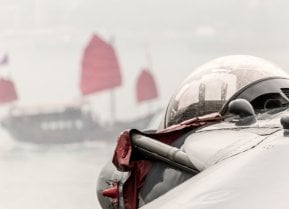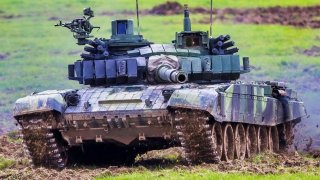Russia's T-72 Tank Is Getting Blown To Pieces in Ukraine
The T-72 was developed by the Soviets at the height of the Cold War. Since its introduction to service in the 1970s, more than 18,000 T-72s have been exported to 30 countries.
Summary: Ukraine’s Special Operations Forces recently claimed to have destroyed two Russian tanks, a modern T-90 and an older T-72, using first-person-view drones in the Donetsk region.

-This highlights the significant tank losses Russia has suffered since its invasion of Ukraine, with estimates of at least 3,000 tanks lost.
-The T-72, a Soviet-era tank, has particularly struggled against Ukraine’s Western-supplied weaponry.
-Despite upgrades like the T-72B3 model, featuring advanced fire control systems and enhanced armor, these tanks remain vulnerable to modern anti-tank measures, including drones.
-As Ukraine continues to receive modern Western tanks, the outlook for Russia’s aging tank fleet remains bleak.
The Struggle of Soviet-Era Tanks: T-72s Hit Hard in Ukraine Conflict
Ukraine’s Special Operations Forces claimed last month that it had taken out two Russian tanks using first-person-view drones in the Donetsk region.
According to a Telegram post, a modern T-90 main battle tank was taken out alongside an older T-72. While the attached footage has not been independently verified, Moscow has lost a great many tanks during its invasion. As of March, the International Institute for Strategic Studies estimated that Moscow had lost at least 3,000 of them since the war began in early 2022. Kyiv claims this number is actually much higher.
The T-72 has perhaps struggled most. First introduced roughly five decades ago, this tank has struggled to survive against Ukraine’s stockpile of Western-delivered weaponry. Open-source intelligence tracker Oryx estimated that Russia lost at least 1,200 of these Soviet-era MBTs during the first year of fighting alone.
Introducing the T-72
The T-72 was developed by the Soviets at the height of the Cold War. Since its introduction to service in the 1970s, more than 18,000 T-72s have been exported to 30 countries. In fact, the Tank Museum at Bovington Camp in southwest England’s Dorset County notes that, “The T-72 is the most widely used main battle tank in the world. It has been manufactured in six countries, is in service with the armies of 35 nations and has fought in all the major wars of the last 20 years.”
The tank’s latest iteration, the T-72B3, was introduced in 2010. Equipped with a slew of enhancements, this model is considered to be a third-generation tank. The MBT is equipped with an advanced fire control system, a 2A46M5 125mm smoothbore gun, and a new thermal sight. The upgraded “Ural” also carries Relikt Explosive Reactive Armor, which provides greater protection against projectiles including tandem warheads and high-velocity missiles.
In addition to these features, the T-72B3 is also fitted with a range of self-protection measures. As detailed by Army Technology, “The T-72B3M MBT is mounted with the new Relikt explosive reactive armour (ERA) replacing the previous Kontakt-5 second-generation ERA. The new armour offers superior protection against shaped charges, tandem warheads, armour-piercing fin-stabilised discarding sabot (APFSDS) rounds, anti-tank guided missiles, as well as low-velocity and high-velocity missiles.”
How Has the Ural Fared in Ukraine?
Like other Soviet-era tanks, the T-72 has struggled against its Western counterparts and anti-tank weaponry in Ukraine. Drones have decimated Russian tanks. These aerial weapons are cheap to produce and easy to operate, contributing to their widespread use by both sides in the war.
But while Moscow’s MBT fleet continues to grow smaller, Ukraine is receiving additional shipments of more modern Western platforms, including the American-made M1A1 Abrams. As the invasion rages on, the future looks grim for Russia’s remaining tanks.
About the Author: Maya Carlin
Maya Carlin, National Security Writer with The National Interest, is an analyst with the Center for Security Policy and a former Anna Sobol Levy Fellow at IDC Herzliya in Israel. She has by-lines in many publications, including The National Interest, Jerusalem Post, and Times of Israel. You can follow her on Twitter: @MayaCarlin.
Image Credit: Creative Commons and Shutterstock.


